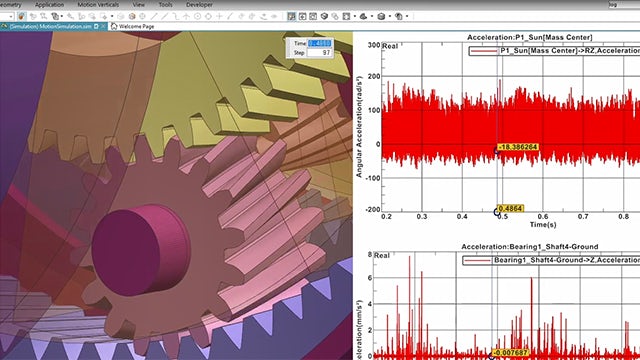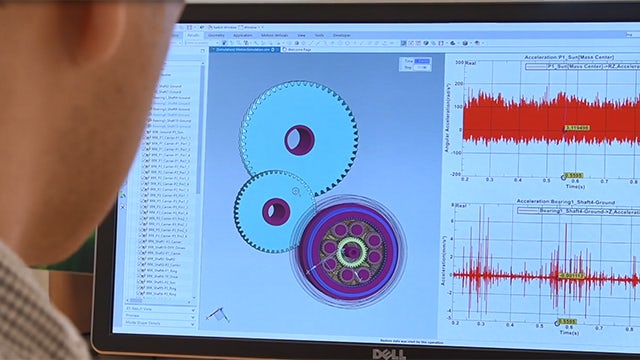Global automotive OEM adopts Siemens Digital Industries Software solutions to minimize transmission gear noise
Simcenter 3D helps Hyundai reduce gear whine in drivetrains
Simcenter 3D Motion Drivetrain is a useful tool that enables us to model the gear train with different levels of fidelity depending on our analysis requirements.
Hyundai Motor Company
Simulating transmission behavior
Engines, tires and transmissions can be major sources of noise, and the noises and vibrations of the transmissions are a special focus. Especially for electric vehicles, in which conventional engines are replaced with electric motors, transmission noise/vibration become more prominent. Therefore, minimizing the transmission noise and vibration is a key engineering activity. Driving a vehicle should be a smooth, quiet and enjoyable experience. Drivers should be able to escape the noise of the hustle and bustle of big-city distractions in the comfort of their modes of transportation.
With the first car coming out of South Korea in 1975, Hyundai Motor Company has now been producing cars for over 40 years. Selling vehicles all throughout the world requires constant emphasis on design and engineering to produce the quality Hyundai is known for.
Utilizing multiple tools
Typically, simulating transmission behavior has been a tedious and error-prone process, requiring multiple simulation tools and long lead times. A key challenge in designing a transmission model that can be used to assess noise or durability is the need to correctly represent not just the overall gear geometry and layout but also the microgeometry of the gear teeth in order to fully capture the nonlinear dynamics. As such, modeling, parameterization and iterations to build a complex model can take days of effort for an experienced engineer.
Another important factor for Hyundai was narrowing down the processes and tools required to perform the tests it wanted to run. “From our experience using similar software tools, we found that one of the most common issues was the time required to create a complex transmission multibody model,” says Horim Yang, senior research engineer at Hyundai Motor Company. “It was very time-consuming. Other packages lack modules to complete a seamless full-scale analysis on a transmission. Sometimes, we had to use multiple software tools together. This was a rather cumbersome workflow. We were looking for a software tool, ideally a multibody software, that can be used with finite element analysis to investigate and solve full vehicle and other NVH issues.”
Hyundai turned to Siemens Digital Industries Software for a solution, selecting Simcenter™ 3D Motion Drivetrain and Simcenter™ 3D Acoustics software. “We had been using different multibody simulation tools for 1D and 3D simulation, but it was difficult to find an adequate software tool with a properly detailed gear dynamic simulation module,” Yang continues. “The Simcenter 3D Motion Drivetrain transmission builder can do a good job for the analysis that we require.”

Eliminating extra steps
With the Siemens solution, Hyundai engineers now apply the latest simulation techniques to determine the best possible components for their vehicles. The ability to run digital simulations greatly reduces the need for physical prototypes early on in product development. This, in turn, means a reduction in the overall cost of the project.
“The tool can be used during the initial design stage to examine how the gear train design parameters influence the system-level dynamic behavior in a drivetrain,” Yang explains. “It can be used to confirm the dynamic performance with a detailed gear train noise and vibration analysis in the final design stage.”
Simcenter 3D Motion Drivetrain and Simcenter 3D Acoustics help automate the creation and simulation of transmission motion models within a single, integrated simulation environment. Hyundai’s goal has been to utilize Simcenter tools to greatly reduce noise, vibration and harshness (NVH) in large cars and SUVs.
Simcenter 3D Motion Drivetrain can help reduce transmission simulation efforts by 80 percent, and is a vertical application that enables engineers to easily define and simulate complex transmission systems based on industry standards. Hyundai engineers can simply enter basic parameters to define the configuration of a transmission system. From these parameters Simcenter 3D automatically creates the full 3D transmission model, including geometry. Hyundai engineers can then set gear contact parameters and operating conditions for the transmission, and the entire model is ready to solve in just minutes instead of hours or days.

Solving complex engineering issues
Additionally, transmission models can then be seamlessly integrated into Simcenter 3D Acoustics to perform gear whine analyses. According to Yang, “Simcenter 3D Motion Drivetrain is a useful tool that enables us to model the gear train with different levels of fidelity depending on our analysis requirements.”
“Thanks to our Simcenter Engineering and Consulting services project with Siemens Digital Industries Software, we hope to establish an efficient workflow to apply multibody simulation results to NVH and durability analysis and find the right software tools that fit our requirements,” says Yang.
It was important for Hyundai to find a solution that gave both the desired output and was easy to use. “From this perspective, the transmission builder software is wellsuited for our engineering purposes,” says Yang. “It has a user-friendly interface.”
We were looking for a software tool, ideally a multibody software, that can be used with finite element analysis to investigate and solve full vehicle and other NVH issues.
Hyundai Motor Company
The tool can be used during the initial design stage to examine how the gear train design parameters influence the system-level dynamic behavior in a drivetrain. It can be used to confirm the dynamic performance with a detailed gear train noise and vibration analysis in the final design stage.
Hyundai Motor Company